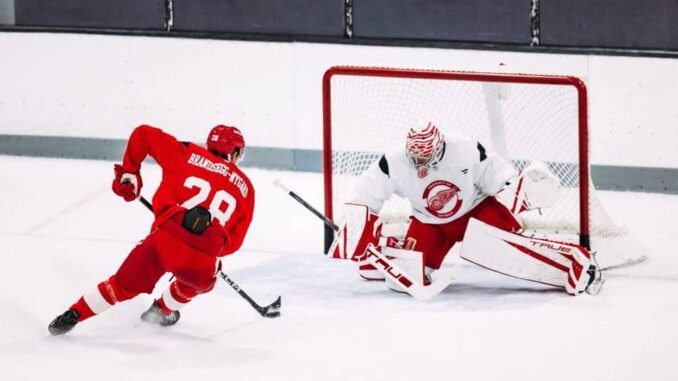
Is John Gibson the Answer to the Red Wings’ Long-Standing Goalie Quest?…Read More…
For years, the Detroit Red Wings have been in search of the one position that can single-handedly shift their fortunes: a dependable, elite goaltender capable of carrying the franchise through the rigors of the NHL season and into playoff contention. While the team has taken strides in rebuilding under the guidance of General Manager Steve Yzerman, the goalie carousel has remained an unresolved question. Now, with reports swirling that veteran netminder John Gibson could be a potential target, the hockey world is asking: could he finally be the solution Detroit has been chasing?
The Red Wings’ Goalie Struggles
The Red Wings’ storied history is filled with legendary names, both on the blue line and upfront, but in recent years, stability between the pipes has been elusive. Jimmy Howard provided years of admirable service, but his decline coincided with Detroit’s fall into rebuild mode. Since then, the team has rotated through a mix of Thomas Greiss, Jonathan Bernier, Ville Husso, and Alex Lyon—each showing flashes but none establishing themselves as the clear No. 1 goaltender. Injuries, inconsistency, and lack of playoff-tested pedigree have left Detroit vulnerable in the crease.
For a team trying to climb out of mediocrity and reestablish itself as a contender, that lack of certainty in goal has been costly. Yzerman’s patient rebuild has brought young talent like Moritz Seider, Lucas Raymond, and the continued brilliance of captain Dylan Larkin, but without a goaltender who can bail out the team when mistakes pile up, the Red Wings remain a step behind the NHL’s elite.
Why John Gibson?
John Gibson has long been a household name in Anaheim, where he has spent his entire career. At 31 years old, Gibson has seen both the highs and lows with the Ducks—backstopping playoff teams early in his career, then enduring years of struggle as Anaheim slid into its own rebuild. Despite facing heavy shot volumes and often playing behind a porous defense, Gibson has consistently been regarded as one of the league’s most talented goalies.
His resume includes multiple All-Star selections, a World Cup of Hockey appearance for Team North America in 2016, and a career save percentage hovering around .910 despite Anaheim’s defensive woes. His style—calm, athletic, and resilient under pressure—would bring a sense of assurance to a Red Wings team still learning how to win consistently.
For Detroit, Gibson represents more than just numbers. He represents experience. He’s faced playoff hockey, battled elite scorers, and maintained composure despite turbulent team situations. Plugging that into Detroit’s roster could elevate the confidence of a young defensive core and provide the stability they’ve been desperate for.
The Concerns
Still, acquiring Gibson wouldn’t be without risk. His contract, which runs through 2026–27 with a $6.4 million cap hit, is a significant commitment. For a team like Detroit, which is still trying to balance veteran contracts with the growth of its young players, such a deal would limit flexibility.
There are also questions about Gibson’s recent play. While still capable of spectacular saves, his numbers have dipped over the past few seasons, partly due to Anaheim’s struggles but also possibly due to wear and tear. Goalies are notoriously unpredictable as they age, and committing to a netminder in his early 30s could backfire if decline sets in faster than expected.
Detroit fans also remember how long-term goalie gambles have worked out across the league—sometimes well, sometimes disastrously. The Red Wings must weigh whether Gibson’s potential upside outweighs the risks of his contract and mileage.
Fit in Detroit
From a purely hockey perspective, Gibson makes sense. Detroit’s defense, anchored by Seider, is improving, and the team is trending toward a more structured game. That environment could help Gibson rediscover his best form. The Red Wings also have a mix of younger goalies in their system, but none appear NHL-ready to take over the No. 1 role in the near future. Gibson could serve as the bridge between the rebuild and contention, buying time for prospects to develop while giving the current roster a legitimate chance to compete.
The Bigger Picture
Bringing Gibson to Detroit would send a strong message: the Red Wings are done rebuilding and ready to take the next step. It would show fans and players alike that Yzerman believes this team is on the verge of playoff hockey. A move like this would echo the confidence the franchise has in its current core and provide a stabilizing force in net.
However, it would also need to come at the right price. Anaheim, entering its own youth movement, might be open to moving Gibson for draft picks or prospects. Detroit has stockpiled assets and could make such a deal, but Yzerman has been notoriously cautious with his moves—rarely overpaying for quick fixes.
Final Verdict
So, can John Gibson be the goalie the Red Wings have been chasing? The answer may lie somewhere in the middle. He has the pedigree, the skill, and the experience to provide Detroit with something it hasn’t had in years: a true No. 1 goalie capable of carrying a heavy workload. At the same time, his contract and recent form raise enough questions to make this a gamble, not a guarantee.
If Detroit believes its time to contend is now, Gibson might be the right player to help them cross that line. If the organization remains patient with the long game, they may choose to let their young talent develop and pursue a different option in the future.
For now, the speculation continues—but one thing is certain: the Red Wings’ quest for stability in goal remains the missing piece in their return to glory, and John Gibson’s name will remain firmly in the conversation.
Leave a Reply